NEW!
RECENT PRODUCTIONS FROM RAVEN'S PERCH MEDIA
Scroll past the brief list below to reach individual descriptions and download buttons
NEW EDITIONS OF VOLUMES 1, 2, AND 3 OF "THE GRAND CANON" ARE NOW AVAILABLE: OPEN "THE GRAND CANON" TAB ON THIS WEBSITE
MANY NEW OFFERINGS UNDER THE "SPECIALIZED BIBLIOGRAPHIES AND HISTORICAL VOLUMES" TAB ARE ALSO NOW AVAILABLE
June 2025
♦ Bibliography of Biology of the Grand Canyon Region, Arizona – Grouped by Higher Taxa – With Annotations – 1853-2025
May 2025
♦ Aerial Grand Canyon: The Bibliographical Record of Aviation and Flight Activity at the Grand Canyon of Arizona
April 2025
♦ A Big Misunderstanding: F. W. von Egloffstein's 1858 Map of the Grand Canyon and Its Influence
♦ Introducing the Grand Canyon: Introductions to Grand Canyon's History from Raven's Perch Media
January 2025
♦ Mapping Grand Canyon: A Chronological Cartobibliography and Chorographical Study. Second Edition
December 2024
♦ Naming the Grand Canyon : with an Appendix, Grand Canyon Echoes (Who named the Grand Canyon?)
DESCRIPTIONS AND DOWNLOAD BUTTONS FOR "NEW!" PUBLICATIONS FOLLOW BELOW
Go to Homepage for introduction to all publications on this website
Users can also download the occasionally updated Raven's Perch Publications List that includes all publication descriptions and live URL links with which to download each publication. Go to the Publications List tab.
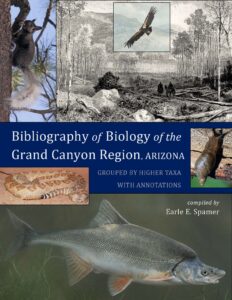
June 2025
Bibliography of Biology of the Grand Canyon Region, Arizona – Grouped by Higher Taxa – With Annotations – 1853-2025
Publications cited in this bibliography are limited to reports and discussions that relate to organisms identified by taxa. Each chapter is modeled on a separate taxonomically-focused bibliography available from Raven’s Perch Media. Each was the Third Edition (2025) of their respective titles, with the exception of that for protists (Second Edition, 2025). They are here consolidated, reformatted, and emended, now making all of the taxonomically-concentrated bibliographies available in one publication. A few citations from a Supplement to THE GRAND CANON Volume 1/Part B (currently in progress, 2025) have been added. Taxonomic names and acts, and revisions to the systematic position of taxa, are those of the original authors as cited in the titles of publications or the annotations provided herein.
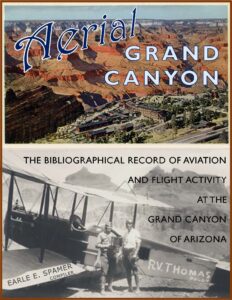
MAY 2025
Aerial Grand Canyon: The Bibliographical Record of Aviation and Flight Activity at the Grand Canyon of Arizona
February 24, 1919, saw the first airplane flight over and into the Grand Canyon. Coincidentally, this was two days before the creation of Grand Canyon National Park. Piloted by 1st Lt. Ralph Olaf Searle with E. D. Jones, U.S. Army Air Service, it was a side trip from a four-aircraft expedition from Texas to California. The following day, another craft from the expedition piloted by Lt. Charles Rugh with Fox News newsreel photographer Lewis Lewyn flew into the canyon. These were the first of several investigations that would be made by the Air Service to analyze the handling of aircraft in that space while also searching for potential landing sites, and the first to promote the Air Service ventures with civilian photographers. It also heralded general aviation flights to and into the canyon—and the harbinger of commercial flights, which came soon.
Aerial Grand Canyon gathers the published record of all manner of aviation events, issues, and policies over more than a century—as many as have been found during the compiler’s work of more than 50 years. The various categories of the topical bibliography in Part 1 best bring to light the types of aviation that have taken place at Grand Canyon. Some of it may reveal new things to some readers; for example, the accounts of those who had (illegally) hang-glided into the canyon and (legally) flown over it wearing only body wingsuits of one sort or another. Aerobatic flying and stunts other than wingsuit flights, and items about aviation infrastructure likewise offer unusual perspectives not often thought about. These are in addition to categories that might be expected, including tourism; general, commercial, and military aviation, rotorwing and lighter-than-air aviation; and aviation accidents, medevacs, aerial searches, and human-safety records.
Part 2 of Aerial Grand Canyon is devoted to the 1956 midair collision of two commercial airliners over the Grand Canyon, in which 128 people died, and which instigated the beginnings of modern air traffic control. Part 3 is a comprehensive bibliographical accounting of government administrative matters relating to Grand Canyon aviation.
Flip Book is Available: https://online.fliphtml5.com/ryvqb/pgsw/

April 2025
A Big Misunderstanding: F. W. von Egloffstein's 1858 Map of the Grand Canyon and Its Influence
In early January 1858, at Fort Yuma, California, Prussian baron Friedrich Wilhelm von Egloffstein joined an exploring expedition under the command of Lt. Joseph Christmas Ives. Their objective was to map the Colorado River and locate its head of navigation, thence explore overland across the northern tier of New Mexico Territory. The mission covertly scouted Mormon advances into the region and sought means by which to gain access to interior locations closer to Utah by way of the river. During the land expedition they hoped to locate the confluence of the Little Colorado River with the main Colorado; in the process they went into the Grand Canyon twice. A veteran of other expeditions in the West, Egloffstein created for Ives’ 1861 final report many scenic illustrations and two shaded relief maps. “Map No. 2” depicts—for the first time—a visual concept of the physiography of the Grand Canyon (“Big Cañon” as it was known then). The technical means that he was still in the process of inventing to make these relief maps has been praised. It was a proprietary and still not wholly understood process of heliography, by which a sculpted plaster model was photographically processed as an engraving in steel. But the topographer has been unfairly criticized for geographical oddities on his map, and the present study aims to remove much of that disapproval. The map displays the results of field-based surveys and adds borrowed and hypothetical topographies. As this study demonstrates, the baron’s survey work was reasonably accurate, and his interpretive work is explicable though he may have been affected by the geographic notions of available maps. Later, cartographers who depended on his map to help produce newer maps of the greater Southwest and North America redrew landscapes in and around the Grand Canyon that were less faithful to ground truth and were not corrected for years. These cartographical trajectories of “Map No. 2” have not been explored before. A Big Misunderstanding is a graphic study of the whole and details of the Grand Canyon map with comparisons to modern and period maps of the region. It rationalizes the limits of visual observation that Egloffstein faced during the land expedition and speculates on what motivated him to fill in the areas that he did not survey. Examples of apparent earlier influences on Egloffstein’s cartographic presentation are illustrated, along with specimens of later maps that distorted his geographies.
This highly graphic publication is best viewed in book format as opposing pages. Many of its illustrations are not recommended for black-and-white printing.
Available in three formats: 1 ) Large PDF file, 2 ) smaller PDF file (images are in slightly lower resolution), and 3 ) a PDF designed for sequential single-page viewing (pages with vertically turned illustrations that take advantage of the long margin of the page are rotated so that all pages in the volume can be viewed in horizontal orientation).
Flip Book is Available: https://online.fliphtml5.com/ryvqb/aelp/
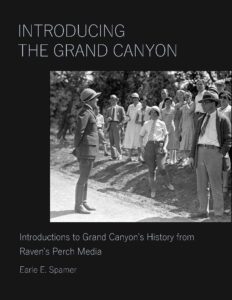
April 2025
Introducing the Grand Canyon: Introductions to Grand Canyon's History from Raven's Perch Media
When Raven’s Perch Media began to produce historically focused publications, some were strictly narratives; others were built around bibliographies about their subjects. Extended informational introductions were added to offer something more interesting to read than a blur of citations—in other words, to give readers something to read. Viewpoints and observations were incorporated that never had been noticed in the published literature, ocassionally spun with a bit of humor. Eye-catching illustrations were inserted, too. These, then, are meant to engage readers, even in those works that were built around a bibliography! But scattered as they are, they fail to impart the idea that Grand Canyon has many particular stories.
One may correctly argue that there are suitable introductions to Grand Canyon’s history already in print. They are admirable, focusing on the canyon’s rich past, highlighting prominent events and people. Yet they necessarily condense some stories, omit others—and retell for the umpteenth time the same old stories that must be given space in every canyon history book no matter its angle. Now Raven’s Perch Media relieves the reader with specific historical aspects that are undetected in the regular histories or may have been bypassed as being beyond the editorial guardrails of structured narratives. It is the prefaces and introductions that hopefully stand out and stand alone.
While these preliminaries can vie for attention, the reader of one book might be unaware of the others, which locate little-occupied vantage points. Thus the purpose of Introducing the Grand Canyon is to assemble these preludes into an anthology. Here, readers can be let into fascinating special aspects that may differ from the regular attentions of Grand Canyon’s history. It is a sampler, of course, but a means by which the Canyon—and the people who were there—can be seen in new light or, for some of them, sighted for the first time.
Flip Book is Available: https://online.fliphtml5.com/ryvqb/qpjt/
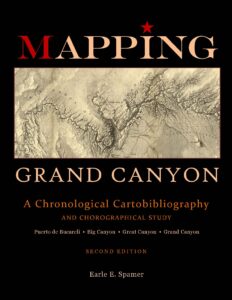
January 2025
Mapping Grand Canyon: A Chronological Cartobibliography and Chorographical Study. Second Edition.
Mapping Grand Canyon focuses on maps on which the Grand Canyon is labeled by one of its four Western-derived names during the past two and a half centuries, though without particular formality or consistency. The four principal sections are Puerto de Bucareli (1777–1884), Big Canyon (1853–1910), Great Canyon (1853–1879), and Grand Canyon (1868–present). (For a general introduction to the evolution of these names, see Naming the Grand Canyon (Raven's Perch Media, 2024).
Flip Book is Available: https://online.fliphtml5.com/ryvqb/oepn/
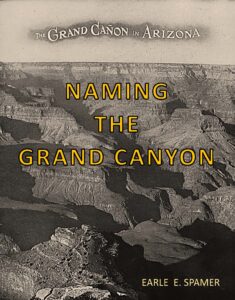
December 2024
Naming the Grand Canyon : with an Appendix, Grand Canyon Echoes
The origin of the name “Grand Canyon” is unknown. It was not the neological invention of John Wesley Powell in 1869, as is often retold. Earlier in the 19th century it was known as “Big Canyon” and “Great Canyon,” perhaps the translation of the term by which French-speaking mountain men may have described it—un grand cañon. Both appellations inattentively survived the coming of “Grand Canyon,” but only for a couple of decades. The earliest known non-Indigenous term, Puerto de Bucareli, was conferred in the diary of the Franciscan friar Francisco Garcés when he visited the Havasupai people in 1776, the first non-Native person known to have reached the Grand Canyon since a party of Spanish conquistadores arrived on the rim 236 years earlier, in 1540 (who are not recorded as having given it a name). Ingenious misspellings of the puerto appeared on manuscript and printed maps in the 18th and 19th centuries but its association as Garcés’s mountain pass for the Colorado River was never remembered, nor did it label an entire canyon. The origins for each “Canyon” name, though, remain mysteries, including the first known appearance of “Grand Canyon” in 1857 that disappointingly lacked an admission of neologism or credit to another source. This has not dissuaded travelers and writers from exploiting the name for other landscapes around the world or from exercising it in a superfluity of analogies and metaphors. In the end, an answer to the question, “Who named the Grand Canyon?” may be unessential, given that Native peoples have had words from time immemorial that affirm long spiritual and cultural associations with the canyon.
Flip Book is Available: https://online.fliphtml5.com/ryvqb/zcfa/
IN PREPARATION
Unscheduled but Recurringly
SUPPLEMENT to Volume 1 (Parts A and B) and Volume 2 of THE GRAND CANON.
While supplements are not always convenient to use in tandem with the works that they annex, a project as large as which the “Bibliography of the Grand Canyon and Lower Colorado River Regions in the United States and Mexico” has become now mandates this course. The bibliography, including the cartobibliography, had come to embrace more than 111,000 citations. After more than 50 years work on this project, it is no longer practical to redistribute every update as a new edition. Furthermore, technical limitations of the online host for Raven’s Perch Media preclude files larger than 100 MB—the PDF file for Volume 1/Part B, the principal bibliography, was fast approaching this figure in 2025. Thus it has been deemed most sensible—technologically as well as for the personal efforts of the project’s single compiler—to now provide a Supplement.
Each subsequent Supplement, which may then be produced at any convenient time, will supersede the previous one, thus offering but one publication to annex the 2025 editions of THE GRAND CANON.